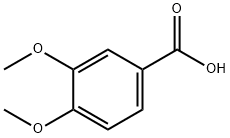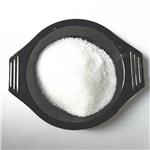Description
Veratric acid (3,4-Dimethoxybenzoic acid) is an orally active phenolic compound derived from vegetables and fruits and has antioxidant and anti-inflammatory activities. It also acts as a protective agent against hypertension-associated cardiovascular remodeling. Veratric acid reduces upregulated COX-2 expression and levels of PGE2 and IL-6 after UVB irradiation. This compound could be reduced to veratrine aldehyde, and alcohol was performed with enzyme extracts from a wood-degrading basidiomycete, Polystictus (Trametes) versicolor[1].
Chemical Properties
white to slightly yellow powder
Uses
3,4-Dimethoxybenzoic acid is a derivative of Protocatechuic Acid.3,4-Dimethoxybenzoic acid is a reagent used in the production of antimicrobial agents, antifeedants, and a variety of other biologically active compounds.
Uses
3,4-Dimethoxybenzoic acid plays an important role in producing antibiotics and various dyes. They are used as intermediates for pharmaceuticals (especially for antipyretic analgesic, antirheumatism) and other organic synthesis. It is used as matrix for ionization of peptides, proteins and carbohydrates.
Definition
ChEBI: A member of the class of benzoic acids that is benzoic acid substituted by methoxy groups at positions 2 and 3.
in vitro
Veratric acid (100, 200 μM) suppresses iNOS expression in LPS-stimulated RAW264.7 cells. Veratric acid (200 μM) inhibits LPS-induced activation of the PI3K/Akt pathway, HAT activation, and HDAC3 expression in RAW264.7 cells.
Veratric Acid (10-100 μg/mL) has anti-inflammatory activity, protects HaCaT cells against UVB-mediated phototoxicity, increases S-phase cells, and prevents UVB-mediated apoptosis.
Veratric acid reduces upregulated COX-2 expression and levels of PGE2, and IL-6 after UVB irradiation.
Purification Methods
Crystallise the acid from Et2O, H2O or aqueous acetic acid. It has m 180-181o after sublimation at 80o/1mm. [Beilstein 10 H 393, 10 I 188, 10 II 261, 10 III 1404, 10 IV 1406.]
References
[1] Gross, Georg G. “From lignins to tannins: Forty years of enzyme studies on the biosynthesis of phenolic compounds.” Phytochemistry 69 18 (2008): Pages 3018-3031.




